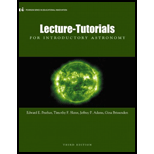
Lecture- Tutorials for Introductory Astronomy
3rd Edition
ISBN: 9780321820464
Author: Edward E. Prather, Tim P. Slater, Jeff P. Adams, Gina Brissenden
Publisher: Addison-Wesley
expand_more
expand_more
format_list_bulleted
Concept explainers
Question
Chapter 3, Problem 7BLP
To determine
The star that gives off more blue light.
Expert Solution & Answer
Want to see the full answer?
Check out a sample textbook solution
Students have asked these similar questions
3
Set
ба
||Axl
49.32
6b
71
Ay
22
Magnitude of A
Angle of A
24.04
Angle of -A
22
54
155.96
° (pos Ax) 204.04
° (neg Ax) 335.96
°
(pos Ax)
° (neg Ax)
115.77
° (pos Ax) 295.77
° (pos Ax)
-39
81
208.78
° (neg Ax) 28.78
°
(neg Ax)
3AA . not sure what i am getting wrong
Chapter 3 Solutions
Lecture- Tutorials for Introductory Astronomy
Ch. 3 - The electromagnetic spectrum of light is often...Ch. 3 - Prob. 2EPLCh. 3 - Prob. 3EPLCh. 3 - Another property of light is the energy. Which of...Ch. 3 - Prob. 5EPLCh. 3 - Prob. 6EPLCh. 3 - Prob. 7EPLCh. 3 - For each statement (a-d) provided below, circle...Ch. 3 - Prob. 9EPLCh. 3 - Which, if any, of the different wavelengths of...
Ch. 3 - Which, if any, of the different wavelengths of...Ch. 3 - Which, if any, of the different wavelengths of...Ch. 3 - Imagine you are comparing the ability of electric...Ch. 3 - Prob. 2LUPCh. 3 - Prob. 3LUPCh. 3 - Imagine you are comparing the ability of electric...Ch. 3 - Two students are discussing their answers to...Ch. 3 - If two hot plates have the same temperature and...Ch. 3 - Likewise, if two stars have the same surface...Ch. 3 - Prob. 8LUPCh. 3 - Prob. 9LUPCh. 3 - Prob. 10LUPCh. 3 - Prob. 11LUPCh. 3 - Prob. 12LUPCh. 3 - Prob. 13LUPCh. 3 - Prob. 14LUPCh. 3 - The graph below plots the luminosity of a star on...Ch. 3 - Which color of light has the greatest energy...Ch. 3 - Imagine that the blue light and orange light from...Ch. 3 - Prob. 3BLPCh. 3 - Prob. 4BLPCh. 3 - Prob. 5BLPCh. 3 - Prob. 6BLPCh. 3 - Prob. 7BLPCh. 3 - Prob. 8BLPCh. 3 - Prob. 9BLPCh. 3 - Using the blackbody curves shown in Figure 2b, for...Ch. 3 - Prob. 11BLPCh. 3 - Prob. 12BLPCh. 3 - Prob. 13BLPCh. 3 - Prob. 14BLPCh. 3 - Consider the blackbody curves for Stars E and D...Ch. 3 - What type of spectrum is produced when the light...Ch. 3 - What type of spectrum is produced when the light...Ch. 3 - Describe in detail the source of light and the...Ch. 3 - There are dark lines in the absorption spectrum...Ch. 3 - Stars like our Sun have low-density, gaseous...Ch. 3 - Prob. 6TYPCh. 3 - Two students are looking at a brightly lit full...Ch. 3 - Prob. 8TYPCh. 3 - In this activity, we will use a representation of...Ch. 3 - One way an atom emits light (photons) occurs when...Ch. 3 - In which case does an atom emit more energy...Ch. 3 - Two students are talking about how light is...Ch. 3 - Prob. 5LIPCh. 3 - At the right is a sketch showing one of the atoms...Ch. 3 - Prob. 7LIPCh. 3 - At the right is a sketch showing one of the atoms...Ch. 3 - Consider the following discussion between the two...Ch. 3 - Prob. 10LIPCh. 3 - The absorption line spectra for six hypothetical...Ch. 3 - Prob. 2ANPCh. 3 - Prob. 3ANPCh. 3 - Prob. 4ANPCh. 3 - Prob. 5ANPCh. 3 - Prob. 7ANPCh. 3 - Prob. 8ANPCh. 3 - Prob. 9ANPCh. 3 -
Consider the situations shown (A-D).
In which...Ch. 3 -
Consider the situations shown (A-D).
In which...Ch. 3 -
In which of the situations shown (A-D) will the...Ch. 3 -
Imagine our solar system is moving in the Milky...Ch. 3 - Prob. 5DOPCh. 3 - Prob. 6DOPCh. 3 - Prob. 7DOPCh. 3 - Prob. 8DOPCh. 3 - Prob. 9DOP
Knowledge Booster
Learn more about
Need a deep-dive on the concept behind this application? Look no further. Learn more about this topic, physics and related others by exploring similar questions and additional content below.Similar questions
arrow_back_ios
SEE MORE QUESTIONS
arrow_forward_ios
Recommended textbooks for you
 College PhysicsPhysicsISBN:9781305952300Author:Raymond A. Serway, Chris VuillePublisher:Cengage Learning
College PhysicsPhysicsISBN:9781305952300Author:Raymond A. Serway, Chris VuillePublisher:Cengage Learning University Physics (14th Edition)PhysicsISBN:9780133969290Author:Hugh D. Young, Roger A. FreedmanPublisher:PEARSON
University Physics (14th Edition)PhysicsISBN:9780133969290Author:Hugh D. Young, Roger A. FreedmanPublisher:PEARSON Introduction To Quantum MechanicsPhysicsISBN:9781107189638Author:Griffiths, David J., Schroeter, Darrell F.Publisher:Cambridge University Press
Introduction To Quantum MechanicsPhysicsISBN:9781107189638Author:Griffiths, David J., Schroeter, Darrell F.Publisher:Cambridge University Press Physics for Scientists and EngineersPhysicsISBN:9781337553278Author:Raymond A. Serway, John W. JewettPublisher:Cengage Learning
Physics for Scientists and EngineersPhysicsISBN:9781337553278Author:Raymond A. Serway, John W. JewettPublisher:Cengage Learning Lecture- Tutorials for Introductory AstronomyPhysicsISBN:9780321820464Author:Edward E. Prather, Tim P. Slater, Jeff P. Adams, Gina BrissendenPublisher:Addison-Wesley
Lecture- Tutorials for Introductory AstronomyPhysicsISBN:9780321820464Author:Edward E. Prather, Tim P. Slater, Jeff P. Adams, Gina BrissendenPublisher:Addison-Wesley College Physics: A Strategic Approach (4th Editio...PhysicsISBN:9780134609034Author:Randall D. Knight (Professor Emeritus), Brian Jones, Stuart FieldPublisher:PEARSON
College Physics: A Strategic Approach (4th Editio...PhysicsISBN:9780134609034Author:Randall D. Knight (Professor Emeritus), Brian Jones, Stuart FieldPublisher:PEARSON

College Physics
Physics
ISBN:9781305952300
Author:Raymond A. Serway, Chris Vuille
Publisher:Cengage Learning

University Physics (14th Edition)
Physics
ISBN:9780133969290
Author:Hugh D. Young, Roger A. Freedman
Publisher:PEARSON

Introduction To Quantum Mechanics
Physics
ISBN:9781107189638
Author:Griffiths, David J., Schroeter, Darrell F.
Publisher:Cambridge University Press

Physics for Scientists and Engineers
Physics
ISBN:9781337553278
Author:Raymond A. Serway, John W. Jewett
Publisher:Cengage Learning

Lecture- Tutorials for Introductory Astronomy
Physics
ISBN:9780321820464
Author:Edward E. Prather, Tim P. Slater, Jeff P. Adams, Gina Brissenden
Publisher:Addison-Wesley

College Physics: A Strategic Approach (4th Editio...
Physics
ISBN:9780134609034
Author:Randall D. Knight (Professor Emeritus), Brian Jones, Stuart Field
Publisher:PEARSON